国际商务课后习题参考答案定稿版
韩玉军《国际商务》课后习题详解(第1~5章)【圣才出品】

韩玉军《国际商务》课后习题详解第一章导论1.试述国际商务的概念、类型与特征。
答:(1)国际商务主要是指国际企业从事国际贸易、国际投资和国际生产过程中产生的跨国经营活动,或者说国际商务是研究围绕这些跨国经营活动产生的相关事务,包括企业的国际战略、策略,资源配置及经营管理,市场开发与拓展,如何遵守、规避国际规则,如何适应不同国家的政治、经济、文化、法律、社会环境,以及如何使自己的思想、产品或服务适应国际市场等。
(2)概括起来讲,国际商务可以分为三大类:①国际贸易,即货物与服务的进出口;②国际直接投资;③特许经营、合作经营、合作开发、工程承包与劳务合作、国际信贷与融资等贸易与直接投资以外的其他国际经济活动。
(3)国际商务的主要特征有三个方面:①国际商务是企业国际化战略的综合反映;②国际商务以进入和开拓国际市场为目标;③国际商务复杂多变、风险大。
2.试述经济全球化的含义、本质、原因与特征。
答:(1)经济全球化是世界上各国和地区之间通过商品、服务及劳动力、资本、信息、技术、管理等生产要素的跨国界流动,寻求资源最优配置的一个互相联系、互相依赖并不断深化的过程。
它主要包括贸易、生产、科技、金融、资本和劳动力流动的国际化与自由化。
(2)关于经济全球化的本质,主要有如下几种观点:①“自由派”观点认为经济全球化是资本扩张的必然结果,所以,经济全球化的本质就是资本主义化甚至可以说是美国化,是美国模式资本主义在全球取得最后胜利的标志。
具体来看这种观点包括两种主要看法:第一,全球化是跨国公司的全球化;第二,全球化的实质是美国化。
②“新马克思主义”观点或“左”派观点认为经济全球化是资本主义化、美国化,因此本质上就是经济殖民主义,是帝国主义发展的新阶段,必须坚决批判与反对。
③“怀疑派”认为历史并没有显现所谓全球化的事实,充其量不过是出现了高水平的国际化,也就是国家之间经济互动而已,经济全球化是某些理论家的神话。
④“变革论”认为全球化是21世纪推动社会经济、政治快速变革的中心力量,这些变革正在重新塑造着现在世界。
希尔《国际商务》(第九版)课后习题详解-政治经济中的国家差异【圣才出品】
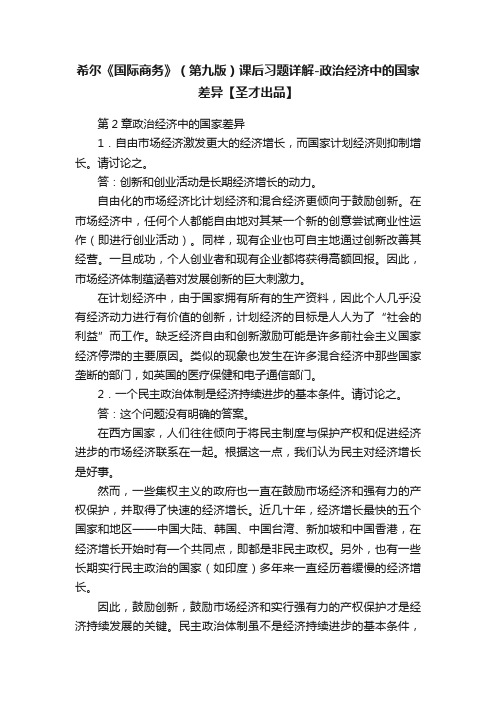
希尔《国际商务》(第九版)课后习题详解-政治经济中的国家差异【圣才出品】第2章政治经济中的国家差异1.自由市场经济激发更大的经济增长,而国家计划经济则抑制增长。
请讨论之。
答:创新和创业活动是长期经济增长的动力。
自由化的市场经济比计划经济和混合经济更倾向于鼓励创新。
在市场经济中,任何个人都能自由地对其某一个新的创意尝试商业性运作(即进行创业活动)。
同样,现有企业也可自主地通过创新改善其经营。
一旦成功,个人创业者和现有企业都将获得高额回报。
因此,市场经济体制蕴涵着对发展创新的巨大刺激力。
在计划经济中,由于国家拥有所有的生产资料,因此个人几乎没有经济动力进行有价值的创新,计划经济的目标是人人为了“社会的利益”而工作。
缺乏经济自由和创新激励可能是许多前社会主义国家经济停滞的主要原因。
类似的现象也发生在许多混合经济中那些国家垄断的部门,如英国的医疗保健和电子通信部门。
2.一个民主政治体制是经济持续进步的基本条件。
请讨论之。
答:这个问题没有明确的答案。
在西方国家,人们往往倾向于将民主制度与保护产权和促进经济进步的市场经济联系在一起。
根据这一点,我们认为民主对经济增长是好事。
然而,一些集权主义的政府也一直在鼓励市场经济和强有力的产权保护,并取得了快速的经济增长。
近几十年,经济增长最快的五个国家和地区——中国大陆、韩国、中国台湾、新加坡和中国香港,在经济增长开始时有—个共同点,即都是非民主政权。
另外,也有一些长期实行民主政治的国家(如印度)多年来一直经历着缓慢的经济增长。
因此,鼓励创新,鼓励市场经济和实行强有力的产权保护才是经济持续发展的关键。
民主政治体制虽不是经济持续进步的基本条件,但持续的经济增长往往能导致民主政体的诞生。
3.在—个国家中,腐败(即政府官员受贿)与该国经济增长之间存在何种关系?腐败是否一定是坏事?答:(1)经济现实显示,高度腐败将在很大程度上减少一个国家的外商直接投资和国际贸易,并导致该国经济增长率的下降。
(NEW)希尔《国际商务》(第11版)课后习题详解
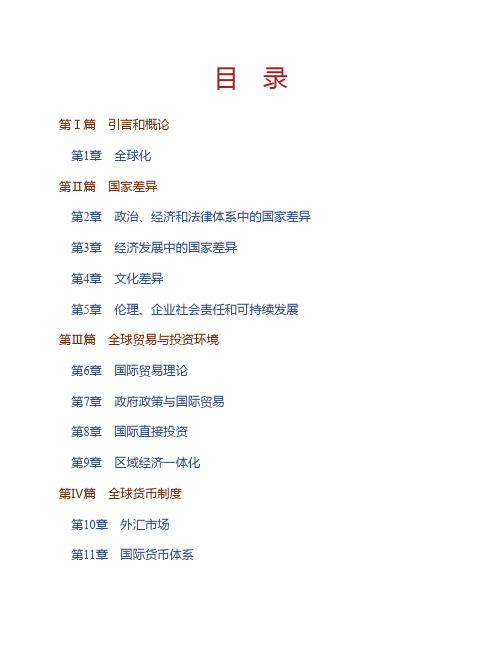
目 录第Ⅰ篇 引言和概论第1章 全球化第Ⅱ篇 国家差异第2章 政治、经济和法律体系中的国家差异第3章 经济发展中的国家差异第4章 文化差异第5章 伦理、企业社会责任和可持续发展第Ⅲ篇 全球贸易与投资环境第6章 国际贸易理论第7章 政府政策与国际贸易第8章 国际直接投资第9章 区域经济一体化第Ⅳ篇 全球货币制度第10章 外汇市场第11章 国际货币体系第12章 全球资本市场第Ⅴ篇 国际企业的战略与组织结构第13章 国际企业的战略第14章 国际企业的组织第15章 进入战略和战略联盟第Ⅵ篇 国际商务运营第16章 出口、进口和对等贸易第17章 全球生产与供应链管理第18章 全球营销与研发第19章 全球人力资源管理第20章 国际企业的会计和财务第Ⅰ篇 引言和概论第1章 全球化1描述在过去30年中世界经济所发生的转变。
这些转变对总部设在英国、北美、中国香港的国际企业各意味着什么?答:(1)过去30年中世界经济所发生的转变在过去30年中,全球经济发生了巨大变化。
20世纪60年代,世界经济的格局可用四个事实来描述:第一是美国在世界经济和世界贸易中起主导作用;第二是美国支配了当时的世界对外直接投资;第三是在国际商务舞台上,美国的大型多国企业占统治地位;第四是地球上大约一半的计划经济国家对西方国际企业的排斥。
在过去30年中,这四个事实都已发生了变化或正在迅速地发生变化:①美国虽仍是世界上最强大的工业国,但在相对规模上较20世纪60年代下降了许多。
日本、泰国、马来西亚、中国台湾和韩国,它们的世界产出份额显著增加。
②各国在对外直接投资总存量中所占的份额的趋势是:发展中国家的份额在稳步增长,而发达国家的份额在逐渐下降。
③多国企业的性质也在变化。
多国企业的统计构成中出现了两个值得注意的趋势:一是非美国的多国公司的增加,尤其是日本的多国企业;二是小型多国公司的增长。
④许多东欧国家和拉美国家进行民主政治改革,实行自由市场经济,为国际企业提供了巨大的出口与投资机会。
国际商务英语课后答案
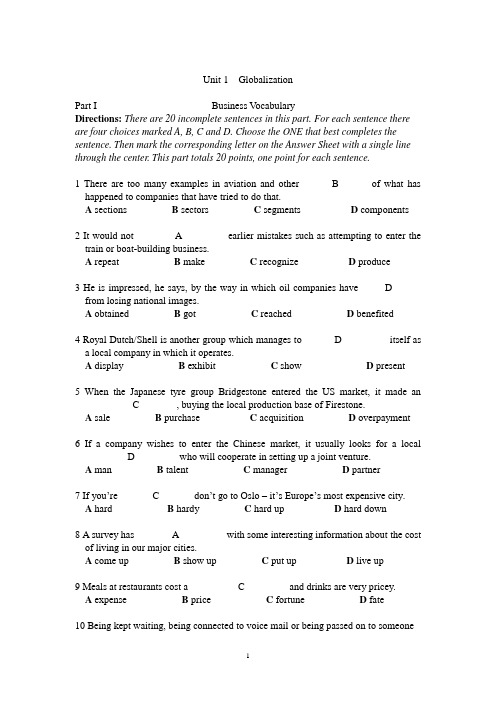
Unit 1 GlobalizationPart I Business V ocabularyDirections: There are 20 incomplete sentences in this part. For each sentence there are four choices marked A, B, C and D. Choose the ONE that best completes the sentence. Then mark the corresponding letter on the Answer Sheet with a single line through the center. This part totals 20 points, one point for each sentence.1 There are too many examples in aviation and other _____ B _____ of what has happened to companies that have tried to do that.A sectionsB sectorsC segmentsD components2 It would not _______ A ________ earlier mistakes such as attempting to enter the train or boat-building business.A repeatB makeC recognizeD produce3 He is impressed, he says, by the way in which oil companies have ____ D _____ from losing national images.A obtainedB gotC reachedD benefited4 Royal Dutch/Shell is another group which manages to ______D_________ itself asa local company in which it operates.A displayB exhibitC showD present5 When the Japanese tyre group Bridgestone entered the US market, it made an _________ C _______, buying the local production base of Firestone.A saleB purchaseC acquisitionD overpayment6 If a company wishes to enter the Chinese market, it usually looks for a local ________ D ________ who will cooperate in setting up a joint venture.A manB talentC managerD partner7 If you’re ______ C ______ don’t go to Oslo – it’s Europe’s most expensive city.A hardB hardyC hard upD hard down8 A survey has _______A_________ with some interesting information about the cost of living in our major cities.A come upB show upC put upD live up9 Meals at restaurants cost a _________ C ________ and drinks are very pricey.A expenseB priceC fortuneD fate10 Being kept waiting, being connected to voice mail or being passed on to someoneelse are all common ________ D _______.A flashesB firesC firecrackersD flashpoints11 Reasons for this are ________ B _________, according to Reed.A three piecesB threefoldC threeD triple12 Increasing numbers of transactions take place entirely by phone, from ___ D ____insurance to paying bills.A doingB sellingC buyingD arranging13 As companies move towards ‘remote working’, the need for the right tone of voice_______ A _______ to every level of the organization.A extendsB stretchesC expandsD attaches14 However, globalization has brought problems in the compan y’s overseas plants,and this is having a bad ________ A _______ on its share prices.A effectB influenceC affectD consequence15 A journalist from the Eastern Economist Review suggested recently that thecompany could become the _______ B _______ of a takeover if it didn’t sort out its problems soon.A aimB targetC objectiveD purpose16 Although this helps to lower costs, the materials are often of poor quality. This hasresulted in _______ C _______ orders.A placedB placingC cancelledD canceling17 Recently, a German distributor refused a D of 50,000 blouses.A dealB transactionC cargoD consignment18 When customers want last-minute changes to clothing, the plants cannot meetcustomers’ tight _______ D ______.A timesB periodsC datesD deadlines19 Its latest _______ B ______ were described by a famous fashion expert as ‘boring,behind the times and with no appeal to a fashion-conscious buyer’.A seriesB collectionsC sequencesD present20 Factory workers complain about their wages. They are often expected to work_______ C ________ without extra pay.A overB timeC overtimeD timelyPart II Phrase TranslationDirections: Directions: There are 20 Chinese phrases in this part. You are required to translate them into English and write down your translation on the Answer Sheet. This part totals 20 points, one point for each phrase.1 资本外逃fight of capita2 福利welfare beneifts3 相互让步give-and-take4 国家形象national image5 航空航天公司aerospace company6 全球化公司global company7 就业问题employment problems8 生活水准living standard9 跨文化问题cross-cultural problem10 合资企业joint venture11 本地合伙人local partner12 许可协议licensing agreement13 通货膨胀率inflation rate14 市场调研market research15 远程办公remote working16 全球会议global conference17 股票价格share price18 顾客需求customers’ needs19 低价战略low-pricing strategy20 员工流动率staff turnoverPart III Sentence TranslationDirections: There are 10 sentences in this part. You are required to translate them into Chinese and write down your translation on the Answer Sheet. This part totals 20 points, two points for each sentence.1.There are too many examples in aviation and other sectors of what has happenedto companies that have tried to do that.在航空业和其他行业中想要原地踏步而以失败告终的例子比比皆是2.People are much more likely to express anger over the phone, rather than inwriting or face to face.和书信及面对面交流比起来,人民更容易在电话上发火。
韩玉军《国际商务》笔记和课后习题详解
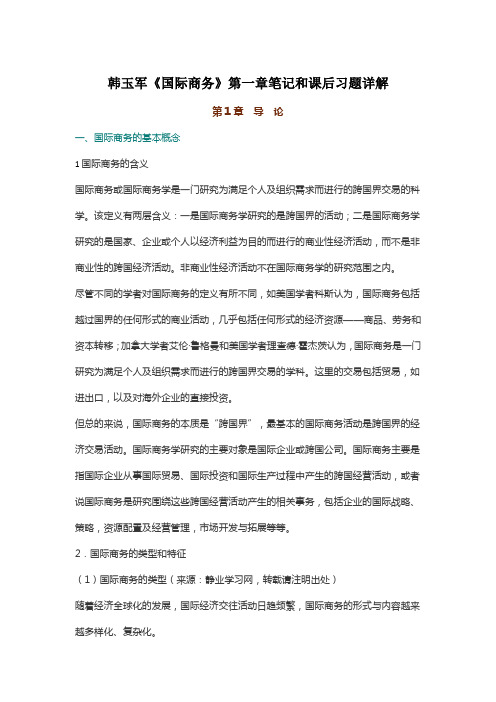
韩玉军《国际商务》第一章笔记和课后习题详解第1章导论一、国际商务的基本概念1国际商务的含义国际商务或国际商务学是一门研究为满足个人及组织需求而进行的跨国界交易的科学。
该定义有两层含义:一是国际商务学研究的是跨国界的活动;二是国际商务学研究的是国家、企业或个人以经济利益为目的而进行的商业性经济活动,而不是非商业性的跨国经济活动。
非商业性经济活动不在国际商务学的研究范围之内。
尽管不同的学者对国际商务的定义有所不同,如美国学者科斯认为,国际商务包括越过国界的任何形式的商业活动,几乎包括任何形式的经济资源——商品、劳务和资本转移;加拿大学者艾伦·鲁格曼和美国学者理查德·霍杰茨认为,国际商务是一门研究为满足个人及组织需求而进行的跨国界交易的学科。
这里的交易包括贸易,如进出口,以及对海外企业的直接投资。
但总的来说,国际商务的本质是“跨国界”,最基本的国际商务活动是跨国界的经济交易活动。
国际商务学研究的主要对象是国际企业或跨国公司。
国际商务主要是指国际企业从事国际贸易、国际投资和国际生产过程中产生的跨国经营活动,或者说国际商务是研究围绕这些跨国经营活动产生的相关事务,包括企业的国际战略、策略,资源配置及经营管理,市场开发与拓展等等。
2.国际商务的类型和特征(1)国际商务的类型(来源:静业学习网,转载请注明出处)随着经济全球化的发展,国际经济交往活动日趋频繁,国际商务的形式与内容越来越多样化、复杂化。
概括起来讲,国际商务可以分为三大类:①国际贸易,即货物与服务的进出口;②国际直接投资;③特许经营、合作经营、合作开发、工程承包与劳务合作、国际信贷与融资等贸易与直接投资以外的其他国际经济活动。
(2)国际商务的特征世界经济全球化迅猛发展,国际商务从原来单纯的货物进出口贸易,发展到服务贸易、技术贸易及各国间的经济合作。
其主要特征有如下几个方面:①国际商务是企业国际化战略的综合反映;②国际商务以进入和开拓国际市场为目标;③国际商务复杂多变、风险大。
国际商务英语简要和课后答案[1].docx
![国际商务英语简要和课后答案[1].docx](https://img.taocdn.com/s3/m/8efd40f2a76e58fafab003f4.png)
International Business EnglishLesson 1International BusinessBusiness Knowledge:The major differences between international business and domestic businessA.Differences in legal systemsB・ Differences in currenciesC.Differences in cultural backgroundD.Different in natural and economic conditionsThe major types of international businessA.Trademodity tradeb.Service tradeB.Investmenta.Foreign direct investmentb・ Portfolio investmentC.Other types3.Licensing and franchisingb.Management contract and contract manufacturingc.Turnkey project and BOTTrade Terms:1.Customs area 关税区:2.Conversion货币兑换3.Visible trade 有形贸易:The form of commodity trade, i.e. exporting andimporting goods produced or manufactured in one country for consumption orresale in another. (including cash transaction-by means of money and market, and counter trade)4.Invisible trade 无形贸易:The form of transportation, communication, banking,insurance, consulting, information etc. is called invisible trade or service industries.5.FD1 外国直接投资:Foreign direct investments. Returns through controlling theenterprises or assets invested in a host country. / P.256. One country acquires assets in a foreign country for the purpose of controlling and managing them.6.Portfolio investment 证券投资:Purchases of foreign financial assets for a purposeother than controlling.7.Stocks 股票:Capital stocks or bonds.& Bonds 债券:The papers issued by a government or a firm with promise to pay back the money lent or invested together with interest・9.Maturity (票据等)到期10.Certificate of deposit 人额存单11・Licensing 许可经营:In licensing, a firm leases the right to use its intellectual property to a firm in another country. They choose licensing because they do not have to make cash payments to stat business, and can simply receive income in the fonn of royalty・12.Franchising 特许经营:Under franchising, franchisee is allowed to operate in thename of another, franchiser who provides the former with trademarks, brand names, logos and operating techniques for royalty・13.Trade Mark 商标14.Patent 专利15.Royalty专利(许可)使用费,版税16.Copyright 版权17.Licenser 许可方1& Licensee被许可方19.Franchiser 特许方:A firm who provides the franchisee with trademarks, brandnames, logos and operating techniques for royalty・20.Franchisee 被特许方:A firm is allowed to operate in the name of anothe匚21.Management contract 管理合同:Under a management contract, one companyoffers managerial or other specialized services to another within a particular periodfor a flat payment or a percentage of the relevant business volume・22.Value chain 价值链23.Turnkey project"交钥匙”工程:For an international turnkey project, a firmsigns a contract with a foreign purchaser and undertakes all the designing,contracting and facility equipping before handing it over to the latter uponcompletion.)24. |B OT建设、经营和移交:Build, Operate, Transfer25.Expertise专门知识26.Bonus红利、奖金、津贴27.Royalty许可使用费28.International investment 国际投资:Supplying capital by residents of onecountry to another.29.Contract manufacturing 承包牛产3(). GATT 关贸总协定:General Agreement on Tariffs and Trade31.International business 国际商务:Transaction between parties from differentcountries. Sometimes business across the borders of different customs areas of the same country is also regarded as import and export・32.Intellectual property 知识产权33.Oil deposit:石油储备=oil reserves34.the reserves of natural resources 自然资源储备35.Personal advancement个人的晋升,个人素质的提高以及个人事业的进步等。
国际商务(南开大学)智慧树知到课后章节答案2023年下南开大学

国际商务(南开大学)智慧树知到课后章节答案2023年下南开大学南开大学第一章测试1.以下哪个选项不属于国际商务的特点()答案:发展中国家地位逐步下降2.市场驱动因素是指()答案:促使企业实施全球化战略的市场方面的影响因素,主要包括顾客需求的逐渐趋同,全球顾客群的成长以及由此产生的全球市场的形成3.以下哪个选项不属于现代国际商务的发展趋势()答案:各国贸易保护主义日益严重4.以下哪项不属于企业从事国际商务活动,与原来只在一国或一个地区内部进行经营活动相比带来的好处()答案:保护本国产业免受其他国竞争影响5.为什么占世界总数的80%的发展中国家,却只有世界财富的10%~20%,其主要原因是()答案:世界经济规则是由发达国家制定的6.以下哪项不属于全球化带来的负面作用答案:融资成本变高7.以下对于国际商务的定义,正确的有()答案:国际商务是跨越国界的任何形式的商业活动,包括任何形式的经济资源——比如商品、劳务和资本的转移。
;国际商务包括那些为满足个人和组织需求而进行的跨越国界的交易,这些交易可以表现为相互联系的不同形式,其基本形式有出口贸易和对外直接投资以及许可经营和管理合同等等。
;国际商务是跨越国界的商务活动,所有这些活动可以发生在个人之间,公司之间,以及其他公共与私人团体之间。
国际商务的关键点包括技术、政治、职能、竞争与环境影响,所有这些影响都会直接影响跨国公司战略。
8.国际贸易的发展历程主要包括以下哪几个阶段()答案:全球商务阶段;贸易主导的阶段;投资主导的阶段9.全球化大大地拓展了人们所能活动的地理范围的同时也使我们可以享受到的产品和服务的种类和数量大大增加,从而也就实实在在的提升了人们生活的质量,也改变了人们的生活方式。
答案:对10.球化会使贫富差距加大而且还会给自然环境带来破坏,所以我们应该抑制全球化。
答案:错第二章测试1.市场全球化的含义为,()的全球化,即独特的、分离的国家市场合并为一个巨大的全球市场。
《国际商务谈判》习题参考答案

第一章习题答案一、名词解释71.谈判:谈判是指各方当事人在一定的条件下,为了满足各自需要而相互协商的活动过程。
2.谈判要素:谈判要素是指构成谈判活动的必要因素,它通常由谈判当事人、谈判议题、谈判背景三个要素构成。
3.谈判议题:又叫谈判客体,它是指在谈判中双方要解决的问题,是谈判者利益要求的体现。
4.原则型谈判:原则型谈判最早由美国哈佛大学研究中心提出,故又称哈佛谈判术。
原则谈判强调公正原则和公平价值,主要有以下四个特征:一是谈判中把人和事分开;二是主张按照共同接受的具有客观公正性的原则和公正价值来达成协议;三是谈判中开诚布公而不施诡计,追求利益而不失风度。
四是努力寻找共同点、消除分歧,争取共同满意的谈判结果。
二、单项选择题1.B;2.C;3.A;4.D;5.B;6.A三、多项选择题1.ABC2.ABCD3.BCD4.ABCD5.ABCD6.BC7.ACD 8.ABCD四、填空题1.谈判2.谈判当事人谈判议题谈判背景3.原则型谈判4.货物买卖谈判投资项目谈判技术贸易谈判劳务谈判索赔谈判。
5.让步型谈判立场型谈判原则型谈判6.主场谈判五、回答题1.你对谈判是如何理解的?它有哪些基本点?答案要点:(1)谈判是指各方当事人在一定的条件下,为了各自需要而相互协商的活动过程。
(2)谈判的定义说明谈判具有目的性、相互性和协商性。
2.构成谈判的基本要素是什么?答案要点:谈判要素是指构成谈判活动的必要因素,它通常由谈判当事人、谈判议题、谈判背景三个要素构成。
3.如何理解谈判的特点?答案要点:谈判的特点是:谈判具有普遍性;谈判具有行为性;谈判既有合作性又有竞争性;谈判成功的标志是达成协议;谈判是信息交流过程。
4.简述谈判的主要类型。
答案要点:谈判的类型主要有:按参加谈判的人数规模划分,可以分为单人谈判和小组谈判;按参加谈判的利益主体数量不同,可以将谈判划分为双边谈判和多边谈判;按谈判进行的地点,可以划分为主场谈判、客场谈判和中立地谈判;按谈判的透明度划分,可以分公开谈判和秘密谈判;按谈判的方式划分,谈判分为口头谈判和书面谈判;按谈判的范围划分,可以分为国内谈判和国际谈判;按谈判内容划分,谈判可以分为,货物货物买卖谈判、投资项目谈判、技术贸易谈判、劳务谈判和索赔谈判;按谈判的方向划分,可以分为纵向谈判和横向谈判;按谈判方所采取的态度与方针划分可以,分为让步型谈判、立场型谈判和原1则型谈判。
希尔国际商务课后答案
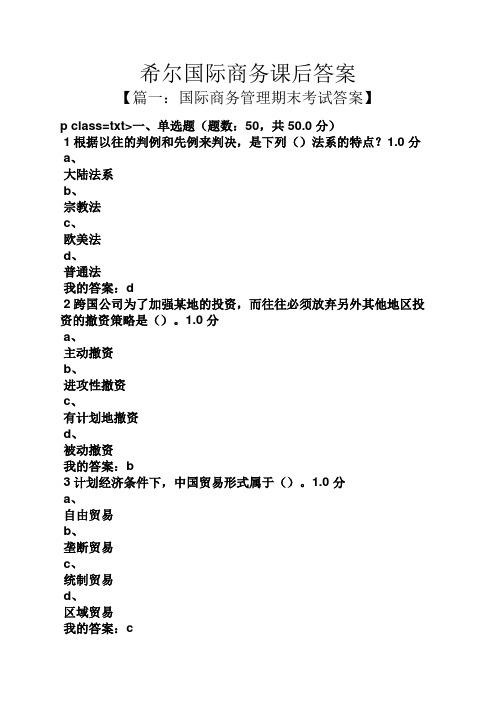
希尔国际商务课后答案【篇一:国际商务管理期末考试答案】p class=txt>一、单选题(题数:50,共 50.0 分)1根据以往的判例和先例来判决,是下列()法系的特点?1.0 分 a、大陆法系b、宗教法c、欧美法d、普通法我的答案:d2跨国公司为了加强某地的投资,而往往必须放弃另外其他地区投资的撤资策略是()。
1.0 分a、主动撤资b、进攻性撤资c、有计划地撤资d、被动撤资我的答案:b3计划经济条件下,中国贸易形式属于()。
1.0 分a、自由贸易b、垄断贸易c、统制贸易d、区域贸易我的答案:c4制定企业的战略目标既要具有可行性,又要考虑到它的先进性,这是指战略目标制定的()。
1.0 分a、关键性b、一致性c、激励性d、稳定性我的答案:c5下列不属于政治风险的是()。
0.0 分a、本国化b、国有化c、当地化d、有偿征用我的答案:d6当前我国外汇储备中最主要的是()。
1.0 分a、欧元b、日元c、黄金d、美元我的答案:d7根据要素禀赋论,下列不适宜发展资本密集型产业的国家是()。
1.0 分a、美国日本c、澳大利亚d、朝鲜我的答案:d8差异化战略的核心是取得某种对顾客有价值的()。
1.0 分a、可靠性b、信誉性c、实用性d、独特性我的答案:d9按照一般跨国公司组织形式发展的第三阶段是()。
1.0 分a、销售部b、出口部c、国际部d、全球结构我的答案:c10下列要素中,不属于国家竞争优势钻石模型中基本要素的是()。
1.0 分a、自然地理环境b、人口c、通讯基础气候我的答案:c11出口补贴作为一种鼓励出口的措施就是在出口某种商品时给予出口商()优惠待遇。
1.0 分a、仅在退还进口税上b、仅在财政上c、仅在现金补贴上d、在现金补贴或财政上我的答案:d12全球化发展的物质基础是()。
1.0 分a、跨国公司的经营成果b、新技术革命提供的成果c、全球性的非管制化和市场化政策d、国际金融市场的深化与创新我的答案:b13重商主义理论盛行于()。
希尔《国际商务》(第7版)笔记和课后习题(含考研真题)详解(全球生产、外包与物流)

希尔《国际商务》(第7版)笔记和课后习题(含考研真题)详解(全球生产、外包与物流)第16章全球生产、外包与物流16.1 复习笔记一、战略、生产和物流生产(production)定义为“涉及产品创造的活动”,包括提供服务和制造产品的活动。
物流(logistics)是指控制原材料在价值链中转移的活动,包括从获得原材料到生产再到分配的过程。
因为公司有效地从事生产活动依赖于物流方面及时地提供高质量的原材料投入,所以生产和物流是紧密联系在一起的。
国际企业中生产和物流的职能有以下重要的战略目标:1.降低成本将生产活动分散到全球各地,每一项活动都得以有效开展,这样就能够降低成本。
有效地管理全球供应链以使供需更好地匹配,这样也能够降低成本。
2.通过消除供应链和制造过程中的次品,提高产品质量降低成本和提高质量这两个目标并不是彼此独立的。
加强质量控制将在三个方面降低成本:(1)因为时间没有被浪费在不适销的劣质产品上,所以生产率提高了。
这项节约直接导致单位成本的减少。
(2)降低了与次品相关的返工和报废成本。
(3)降低了与修理次品相关的保修成本和花费更少的时间。
大部分管理者用来增强产品可靠性的主要手段是六西格玛质量改进理念。
六西格玛理念是从全面质量管理(total quality management,TQM)体系直接演变而来的。
如今六西格玛(six sigma)理念取代全面质量管理体系,它是旨在全公司范围内减少次品、提高生产率、消除浪费和削减成本的统计上的理念。
除了降低成本和提高质量两个目标,还有两个目标在国际商务中尤其重要。
其一,生产和物流必须适应当地反应的需要。
其二,生产和物流必须能对客户需求的转变迅速作出反应。
二、选择生产地跨国公司面临的一个基本决策是在哪里从事生产活动,以最好地实现成本最小化和提高产品质量的双重目标。
考虑的因素按三个大标题可分为国家因素、技术因素和产品因素。
1.国家因素政治经济、文化和相对要素成本在国与国之间是不同的。
《国际商务导论》课后思考题答案
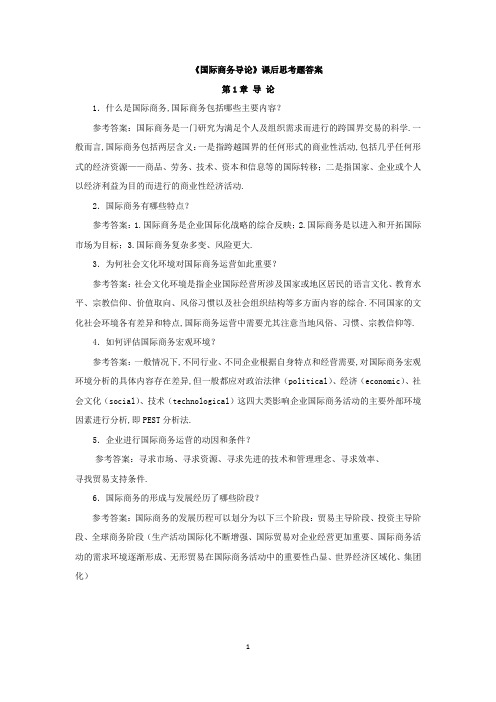
《国际商务导论》课后思考题答案第1章导论1.什么是国际商务,国际商务包括哪些主要内容?参考答案:国际商务是一门研究为满足个人及组织需求而进行的跨国界交易的科学.一般而言,国际商务包括两层含义:一是指跨越国界的任何形式的商业性活动,包括几乎任何形式的经济资源——商品、劳务、技术、资本和信息等的国际转移;二是指国家、企业或个人以经济利益为目的而进行的商业性经济活动.2.国际商务有哪些特点?参考答案:1.国际商务是企业国际化战略的综合反映;2.国际商务是以进入和开拓国际市场为目标;3.国际商务复杂多变、风险更大.3.为何社会文化环境对国际商务运营如此重要?参考答案:社会文化环境是指企业国际经营所涉及国家或地区居民的语言文化、教育水平、宗教信仰、价值取向、风俗习惯以及社会组织结构等多方面内容的综合.不同国家的文化社会环境各有差异和特点,国际商务运营中需要尤其注意当地风俗、习惯、宗教信仰等.4.如何评估国际商务宏观环境?参考答案:一般情况下,不同行业、不同企业根据自身特点和经营需要,对国际商务宏观环境分析的具体内容存在差异,但一般都应对政治法律(political)、经济(economic)、社会文化(social)、技术(technological)这四大类影响企业国际商务活动的主要外部环境因素进行分析,即PEST分析法.5.企业进行国际商务运营的动因和条件?参考答案:寻求市场、寻求资源、寻求先进的技术和管理理念、寻求效率、寻找贸易支持条件.6.国际商务的形成与发展经历了哪些阶段?参考答案:国际商务的发展历程可以划分为以下三个阶段:贸易主导阶段、投资主导阶段、全球商务阶段(生产活动国际化不断增强、国际贸易对企业经营更加重要、国际商务活动的需求环境逐渐形成、无形贸易在国际商务活动中的重要性凸显、世界经济区域化、集团化)第2章国际贸易理论1. 单选题(1)主张一国应集中生产优势最大或劣势最小的产品的国际分工理论是()A.绝对优势理论 B. 比较优势理论 C. 异质性企业贸易理论 D. 产业内贸易理论参考答案:B(2)提出各国应按照生产要素禀赋进行国际分工的经济学家是()A.亚当·斯密 B. 里昂惕夫 C. 赫克歇尔和俄林 D. 大卫·李嘉图参考答案:C(3)主张各国按绝对有利的生产条件进行国际分工的理论是()A.绝对优势理论 B. 比较优势理论 C. 产品生命周期理论 D. 产业内贸易理论参考答案:A(4)要素禀赋理论认为,国际贸易将会使各国生产要素价格的差别()A.变大 B. 变小 C. 不变 D. 无法确定参考答案:B(5)一国拥有的资本要素充裕,就应专门生产并出口资本密集型产品,这一说法来自()A.绝对优势理论 B. 比较优势理论 C. 要素禀赋理论 D. 产业内贸易理论参考答案:C2. 多选题(1)广义的要素禀赋理论包括()A.罗伯津斯基理论 B. 要素价格均等化理论 C.H-O理论D. 产业内贸易理论参考答案:ABC(2)产业内贸易的商品必须具备的两个条件是()A.消费上能够相互替代 B. 劳动密集型产品 C. 生产中需要相近或相似的生产要素投入 D. 资本密集型产品参考答案:AC(3)对里昂惕夫之谜的解释的理论有()A.劳动熟练说 B. 自然资源说 C. 技术差距说 D. 人力资本说参考答案:ABD(4)英国生产一单位酒需要120人/年,生产一单位毛呢需要100人/年;葡萄牙生产一单位酒需要80人/年,生产一单位毛呢需要90人/年,根据比较优势理论,()A.英国应该生产和出口酒 B. 英国应该生产和出口毛呢 C. 葡萄牙应该生产和出口酒D. 葡萄牙应该生产和出口毛呢参考答案:BC(5)动态的国际贸易的理论有()A.要素禀赋理论 B. 产品生命周期理论 C. 技术差距理论 D. 异质性企业贸易理论参考答案:BC3. 简答题(1)绝对优势理论的基本观点是什么?参考答案:绝对优势理论的基本观点是各国应该集中生产并出口其具有劳动生产率和生产成本“绝对优势”的产品,进口其不具有“绝对优势”的产品.贸易的双方都会从贸易中获利.(2)比较优势理论的核心思想是什么?与绝对优势理论有什么区别?参考答案:李嘉图的比较优势理论认为贸易的基础是生产技术的相对差别.每个国家应该集中生产并出口其具有“比较优势”的产品,进口其具有“比较劣势”的产品.绝对优势理论比较是直接在二者中选出谁好谁劣,而比较优势理论则是“两利相权取其重,两弊相权取其轻.”;绝对优势理论只能说明各国分别在某一种或某几中产品的生产上,劳动生产率高于其他国家,分工得以形成,而比较优势理论还可以解释当一国在所有产品的生产上劳动生产率都高于他国时国际贸易得以成立的原因;绝对优势理论是同一产品一国对另一国的优势,是内生的,而比较优势理论是同一国一产品对另一种产品的优势,是外生性的.(3)要素禀赋理论的基本内容是什么?参考答案:要素禀赋理论认为国家贸易的基础是生产要素的禀赋和使用比例的相对差别,各国倾向于集中生产并出口那些密集使用本国充裕资源的产品,进口那些密集使用本国稀缺资源的产品.(4)基于局部均衡分析要素禀赋理论下贸易影响和贸易所得.参考答案:①贸易影响:没有贸易时出口国的国内市场均衡价格<国际市场价格<没有贸易时进口国的国内市场均衡价格.进口国外商品会导致国内同类产品价格下降,生产减少,消费增加.出口产品的价格上升,生产增加,国内消费减少.②贸易所得:对出口国而言,出口产品价格提高,使“消费者剩余”减少,但对生产者来说,出口则带来了很大利益:既增加了产量,又提高了价格,“生产者剩余”增加,出口使本国消费者受害而生产者得益.对进口国而言,从生产者的角度来讲,自由贸易并非一件好事,在廉价进口的冲击下,“生产者剩余”减少.但正是由于廉价外国产品的进口,使得“消费者剩余”增加,进口使本国消费者受益生产者受损.无论是对进口国还是对出口国而言,贸易使该国的整体福利增加.具体分析见本章第3节.(4)什么是里昂惕夫之谜?西方学者对此作了哪些解释?参考答案:里昂惕夫1947年运用投入一产出分析法考察美国对外易商品结构,拟对H-O 定理进行实践上的验证时,却发现美国出口的是劳动密集型产品,进口的却是资本密集型产品,而美国显然是一个资本雄厚而劳动相对不足的国家.这一结论与赫克歇尔、俄林的观点完全相反.西方学者提出了人力资本说、熟练劳动说、自然资源论、要素密集度逆转论、需求偏向论和贸易保护论六种解释.(5)什么是产业内贸易?其产生的原因是什么?参考答案:产业内贸易,是指同一产业部门具有相似的要素投入和消费替代性的产品通过外部或内部市场在不同国家或地区间的双向流动,简单地说,它是指一个国家或地区既进口又出口同一产业部门的现象,在某些研究中,又被称为双向贸易或重叠贸易.产业内贸易理论中所指的产业,必须具备两个条件:一是生产投入要素相近;二是产品在消费上可以相互替代.产生的原因主要有产品的同质性、规模经济和经济发展水平三方面.(6)简述产品生命周期理论的主要内容.参考答案:从创新国与模仿国的角度,将产品生命周期划分为五个阶段.第一阶段为新产品阶段.在这一阶段,由于新产品刚刚问世,仅在创新国生产和消费,所以既无出口也无进口.第二阶段为产品成长阶段.在这一阶段,创新国对新产品进行了改进,使产量迅速提高.此时,国外还不能生产这种产品,故创新国在国内外市场都拥有垄断地位.在这一阶段,将有一定量的新产品出口到国外,主要是其他一些发达国家.第三阶段为产品成熟阶段.新产品在创新国已经标准化,创新厂商开始授权外国厂商生产这种产品.第四阶段为其他发达国家参与新产品的出口市场竞争.模仿国不仅为本国消费者生产,而且出口产品,并且成为该产品的主要出口国.第五阶段为创新国成为该产品的进口国.由于外国的技术水平与创新国的技术水平逐渐接近,同时外国的工资水平仍低于创新国,因此该产品在其他一些发达国家生产和出口,而创新国逐渐成为该产品的净进口国.此外,由于技术日益陈旧,技术的转让费用越来越低,技术逐渐在发展中国家扩散,一些发展中国家开始引进该产品的技术进行生产和出口,最后发展中国家成为该产品的主要生产国和出口国.(7)国家竞争优势理论的主要内容.参考答案:迈克尔·波特的国家竞争优势理论认为,一国的国内经济环境对企业开发其自身的竞争能力有很大影响,其中影响最大、最直接的因素是以下四项因素:生产要素、需求要素、相关和支持产业以及企业战略和组织结构.第3章对外直接投资理论国际直接投资的基本理论有哪些?参考答案:国际直接投资的基本理论包括垄断优势理论、内部化理论、国际生产折衷理论、对外直接投资发展阶段理论和投资诱发要素组合理论.简述垄断优势理论的主要内容及其重要发展.参考答案:垄断优势理论认为,在完全竞争的市场条件下,国际贸易是跨国企业进入国际市场的唯一方式,并根据比较优势原则从事进出口活动;而市场不完全性的存在使得一些企业取得了垄断优势,这些垄断优势则成为企业对外直接投资的根本动力和决定因素.在二十世纪六、七十年代,众多西方经济学家在海默与金德尔伯格研究的基础上进一步对垄断优势理论进行了发展与完善,主要包括约翰逊“知识资产垄断优势理论”、凯夫斯“产品异质化垄断优势理论”、尼克博克“寡占反应垄断优势理论”和阿哈罗奈“生产技术垄断优势理论”.目前跨国公司内部贸易增长较快,请以内部化理论解释该现象.参考答案:内部化理论认为世界市场是不完全竞争的市场,跨国公司为了其自身的利益,为克服外部市场的某些失效以及某些产品的特殊性质或垄断势力的存在,导致企业市场交易成本的增加.而通过国际直接投资, 公司可以将本来应在外部市场交易的业务转变为在公司所属企业之间进行,并形成一个内部市场.从而通过外部市场内部化降低交易成本和交易风险. 国际生产折衷理论的主要内容有哪些?如何评价?参考答案:国际生产折衷理论的核心为“三优势模式”(O.I.L.Paradigm),即跨国公司经营决策是由所有权优势、内部化优势和区位优势三组变量决定的.一国企业是否应从事国际生产和对外直接投资,应当全面研究和评价它是否具备所有权优势、内部化优势和区位优势,三类优势是相互结合、缺一不可的,任何一类优势都不能单独用来解释国际生产和对外直接投资的倾向,只有同时具备这三类优势才能进行对外直接投资.若只拥有所有权优势而无力将其内部化,同时也不能利用国外的区位优势,则最好采用许可证合同的方式转让技术;若公司具备所有权优势且能够将其内部化,但仍然不具备区位优势,则其最优选择为国内生产然后出口;若公司同时具备所有权优势、内部化优势和区位优势,则企业应当选择对外直接投资.邓宁的国际生产折衷理论融合了自海默以来的多家国际直接投资理论学派,具有高度的概括性和综合性,用以评价在对外直接投资的起因和发展方面影响重大的一系列因素,较为全面准确地解释了跨国公司的国际生产活动,成为国际直接投资理论中影响最大、最为深远的理论框架,被称为对外直接投资的“通论”.对外直接投资发展阶段理论与国际生产折衷理论的区别在哪里?参考答案:国际生产折衷理论的研究对象是发达国家的跨国公司,而对外直接投资发展阶段理论则是形成了一个对发达国家和发展中国家普遍适用的国际直接投资理论框架;国际生产折衷理论认为一个国家的对外直接投资倾向只取决于其所拥有的所有权优势、内部化优势以及区位优势,而对外直接投资发展阶段理论则认为对外直接投资的一部分是国家特定优势或企业特定优势的函数,另一部分是该国经济发展阶段的函数.简述投资诱发要素组合理论的基本内容.参考答案:投资诱发要素组合理论认为,任何形式的对外直接投资都是在投资直接诱发要素和间接诱发要素的组合作用下而发生的.所谓直接诱发要素,主要是指各类生产要素,包括劳动力、资本、资源、技术、管理及信息知识等.间接诱发要素是指除直接诱发要素以外的其他诱发对外直接投资的因素,主要包括三个方面:(1)投资国政府诱发和影响对外直接投资的因素.(2)东道国诱发和影响对外直接投资的因素.(3)全球性诱发和影响对外直接投资的因素.发达国家对外直接投资主要是直接诱发要素在起作用,这与他们拥有某种要素优势有关,如资本、技术、管理等.而发展中国家则相反,由于他们相对于发达国家缺乏明显的直接诱发要素优势,对外直接投资很大程度上受间接诱发要素影响.间接诱发要素对当代国际直接投资起着越来越重要的作用.第4章国际收支与汇率理论1.什么是一价定律?它有什么假设?使用范围是什么?参考答案:一价定律可表述为,当贸易是开放的且交易费用为零时,同样的货物无论在何地销售,其价格都必然相同.即:表示商品的国内价格,表示的是商品的国外价格,为两国间的汇率.一价定律的成立需要满足严格的限制条件,例如没有额外交易成本的假设.同时,一价定律并不适用于世界上所有的商品和服务,因为某些商品和服务(例如理发等)是非贸易品,各国的消费习惯、经济发展阶段与产业结构的差异也会扭曲一价定律.2、购买力平价理论的贡献有哪些?有哪些缺陷?能否真实反映一国的经济发展水平?参考答案:购买力平价理论提出了纸币制度下决定汇率的基础,可以判断一国货币币值是否被高估或低估,为制定正确的汇率政策提供依据.同时,它还可以作为换算工具,用来比较各国的主要国民经济指标,避免按照市场汇率转换而产生的偏差.购买力平价理论的缺陷在于,各国国内都存在一些不进入国际贸易领域、不参与国际交易的商品和劳务,无法衡量其价格水平;它要求不同市场上的同类、同质商品的价格通过国际贸易趋向相等,这一条件存在的前提国家间的自由贸易和交易成本为零,但在国际贸易的实践中,存在着种种人为障碍(如关税壁垒、进口配额、进口许可证制、外汇管制以及市场上存在的垄断力量等)和自然障碍(如贸易本身所涉及的运输成本和保险费用等),因此,贸易商品的价格是不可能完全趋向相等的.该理论并不能真实反映一国的经济水平.因为在购买力平价理论的框架中,消费者偏好的变化、生产技术的进步、资本货物或生产资料的积累、市场结构的改变以及国民收入的增长等实际因素对汇率的影响被简化,该理论仅仅在货币性经济变量之上进行分析,将实际性经济变量以及人们的预期心理因素排斥在外.政府实施的管制及其他干预措施、市场参与者的预期心理出现的频繁变化等因素,也都会阻碍货币汇率对通货膨胀率差异作出充分的调整,从而使得购买力平价难以成立.3、利率平价方程说明了什么?如何理解现实中对利率平价的偏离?参考答案:利率平价方程表明:如果国内利率高于国外利率,远期外汇将升水;反之则贴水,而且升(贴)水率等于利率差异.现实中对利率平价的偏离情况为投资者提供了机会,根据利率平价对现实偏离的方向进行分析,既可以让风险爱好者赖以牟利,也可以为风险规避者提供避险的依据.4.西方发达国家的学者们根据购买力平价计算的结果,认为中国经济发展水平目前已经位居世界前列,并据此对中国以发展中国家的身份加入世界贸易组织的要求设置种种障碍.试根据购买力平价的缺陷谈谈你的看法.参考答案:参照第二题.购买力平价说本身就存在许多缺陷,因此给予此理论的论述可以作为特定假设下的参考,而用于政策制定则难免有失偏颇.5.如果分别代表本国和外国利率水平,分别代表以间接标价法表示的即期汇率与远期汇率,而且远期期限与利率期限相同.试推导利率平价条件并解释它为什么会成立?参考答案:如果用本币投资于本国金融市场,则1单位本国货币到期可增值为.如果这一单位本币用于投资于外国金融市场,则这一投资行为分为三个步骤:(1)先在外汇市场上兑换为外币,在间接标价法下,可得单位的外币;(2)再投资于外国金融市场,一年后可得外币:个单位;(3)存款到期后,将外国货币在外汇市场上按照远期汇率换成本国货币,可得本币:个单位.如果,则众多的投资者都会将资金投入外国金融市场,这导致外汇市场上即期购入外国货币以及远期卖出外国货币行为增多,从而使本币即期贬值(增大),远期升值(减小),投资于外国金融市场的收益率下降,反之亦然.只有当这两种投资方式的收益率完全相同时,市场才处于平衡状态.所以,当投资者采取持有远期合约的抛补方式交易时,市场会最终使利率与汇率之间形成下列关系:.记即期汇率与远期汇率之间的升(贴)水率为,整理得间接表示法下的利率平价公式:,其经济含义是:汇率的远期升贴水率等于两国货币利率水平之差.6、假定美国与瑞士的利率分别为,即期汇率为1美元等于1.1314瑞士法郎,试计算瑞士法郎三个月的远期汇率.参考答案:第5章国际贸易与世界市场1.什么是区域经济一体化? 它有哪些形式?参考答案:区域经济一体化是指位于某一地理区域内的各个国家通过相互合作,削减或消除国与国之间的商品、劳务和资本的流通壁垒的过程被.区域经济一体化可以划分为以下几种形式,其中每一种经济一体化形式都包含了比它更低层次的一体化形式的所有特点.主要包括特惠贸易安排、自由贸易区、关税同盟、共同市场、经济同盟和完全的经济一体化.2.试分析自由贸易区与关税同盟的区别.参考答案:自由贸易区通常指签订有自由贸易协定的国家所组成的经济贸易集团,成员国相互取消关税和数量限定,使区域内各成员国的商品可以自由流动,但各成员国仍保留独立的对非成员国的关税和其他贸易壁垒,以及保持其内外经济政策的独立性.其重要特征是在该一体化组织参与者之间取消了商品贸易的障碍,成员国内的厂商可以将商品自由的输入和输出,真正实现了商品的自由贸易,但是它严格地将这种贸易待遇限制在参与国或成员国之间.自由贸易区的另一个重要特征是成员国之间没有共同对外关税.而关税同盟是指成员国根据缔结的协定,将各自的关税合并为一个统一的关税,成员国之间取消关税和进口数量限制,对从同盟以外的国家进口的货物实行统一的关税和进口数量限制.关税同盟规定成员国之间共同、统一的对外关税,实际上是将关税的制定权让渡给经济一体化组织.它不像自由贸易区那样,只是相互之间取消关税,而不作权利让渡.因此,关税同盟对成员国的约束力比自由贸易区大.3.简述WTO的基本原则.参考答案:世界贸易组织建立的协定是国际贸易制度运行和各成员国贸易政策制定的法律基础,它继承了关贸总协定的主要原则,比关贸总协定约束的范围更加广泛,它是一个真正意义上的国际贸易体系. 在世界贸易组织建立的协定中,明确指出了五个基本原则,即非歧视原则、通过谈判逐渐推行贸易自由化原则、可预见原则、促进公平竞争原则和鼓励发展与改革原则.非歧视原则,即贯彻最惠国待遇和国民待遇原则,非歧视原则在关贸总协定中作了明确的规定.贸易自由化原则是指通过减少贸易障碍来促进贸易的扩大.这些贸易障碍不仅是指进口关税,还包括各种数量限制、政府的某些限制进口的规定以及汇率政策等方面的限制措施.可预见性原则是指各成员国在其贸易政策或规定执行以前,要对成员国公开并通知世界贸易组织.鼓励公平竞争的原则是指世界贸易要在公开、公正和不受干预的情况下开展,因而该体系反对倾销、补贴及政府的歧视性采购等.鼓励发展与改革原则是指对发展中成员国的经济发展和改革采取鼓励原则.4.关贸总协定通过八轮谈判成功地降低了各成员国货物贸易中的关税和非关税壁垒,为什么还要成立WTO?参考答案:关贸总协定的制定使得国际贸易能够在一个比较自由的贸易环境下展开.但关贸总协定在设立时,主要是针对货物贸易及其相关产业部门的贸易问题而设定的规则协议,这就制约着缔约国之间贸易范围的发展扩大,如服务贸易和知识产权等贸易问题.1986年9 月,关贸总协定在乌拉圭启动第八轮谈判(又称乌拉圭回合),谈判议题中涉及了服务贸易和与贸易有关的知识产权等非货物贸易问题.这些重大议题的谈判成果很难在关税与贸易总协定的框架内付诸实施,使得创立一个正式的国际贸易组织的必要性日益突出.5.分析北美自由贸易区成立的原因.参考答案:促使北美自由贸易区成立的原因主要有三个方面.第一,美、加、墨三国具有实行经济一体化的可能性.三国地理位置紧紧相连,语言文字、价值观念和风俗习惯等都具有相似性.三国的经济互补性加强且依存度很高.第二,是来自欧洲经济一体化的压力.20世纪80年代以来,世界经济一体化成为世界经济的一个突出现象.为了适应激烈的竞争,更多的国家组成新的区域经济一体化组织或者加入到原有的一体化组织当中.欧洲一体化的扩大和深化使美国倍感压力.美国清楚地认识到,统一大市场将使自己面临一系列的难题.单靠自己的力量,不足以应付来自欧共体和其他区域经济体的挑战,建立以美国为首的区域经济一体化组织,以整体力量与其他一体化组织对抗,才可以保持在世界经济中的主导地位.第三,符合北美各成员国发展经济的需要.建立北美自由贸易区,实行美、加、墨三国经济一体化,对美国而言,既可以扩大商品出。
韩玉军《国际商务》课后习题详解(第11~15章)【圣才出品】

韩玉军《国际商务》课后习题详解(第11~15章)【圣才出品】韩玉军《国际商务》课后习题详解第十一章国际商务组织1.请比较全球地区分部结构和全球产品分部结构,并结合组织结构阶段模型说明它们各自适合于具有什么特点的跨国公司。
答:(1)全球地区分部结构全球地区结构,又称为区域事业部制,是指跨国公司根据全球不同地区划分分部,地区分部在很大程度上是独立自治的实体,并拥有各自的价值创造活动。
地区分部拥有经营领导权和与各项价值创造活动有关的战略决策权,而总部掌握公司总的组织战略方向和财务控制权。
①优缺点:由于全球地区结构采取分权的管理方式,决策权的下放有助于促进各分部对地区的适应。
然而这种组织结构也会将组织分割成一个个高度自治的实体,阻碍地区间核心竞争力和技术的转移。
②适用性:产品多样化程度低而且国内组织结构以职能为基础的企业适合采用全球地区分部结构。
(2)全球产品分部结构全球产品分部结构是指以公司主要产品的种类及相关服务的特点为基础,在全球范围内设立若干产品分部。
每一个分部都是一个自给自足、大体上自治的实体,并对其价值创造活动负全部责任。
总部负责公司的整体组织战略发展和财务控制。
①优缺点:全球产品分部结构使得同一产品部门内有关的职能活动协调比较容易,并且每一个产品部都是一个独立的利润中心,有利于评价各部门的业绩,同时这容易适应企业的扩展与业务多元化要求。
全球产品分部结构的缺陷有:地区或各国经理被视为产品分部经理的下属,发言权受到了限制,这可能导致缺乏地区的调适;企业由于产品种类的不同而在相同的地区设立相同职能的多个机构,造成机构设置的重叠;每一个产品分部都有一定的独立权力,高层管理人员有时会难以控制;对总部的各职能部门,产品分部往往不充分利用,导致总部资源的浪费。
②适用性:产品相当多样化和原先在国内的组织结构是以产品划分部门的企业倾向于采用全球产品分部结构。
2.试述全球矩阵结构和网络型组织结构各自的优缺点。
国际商务英语课后答案.docx
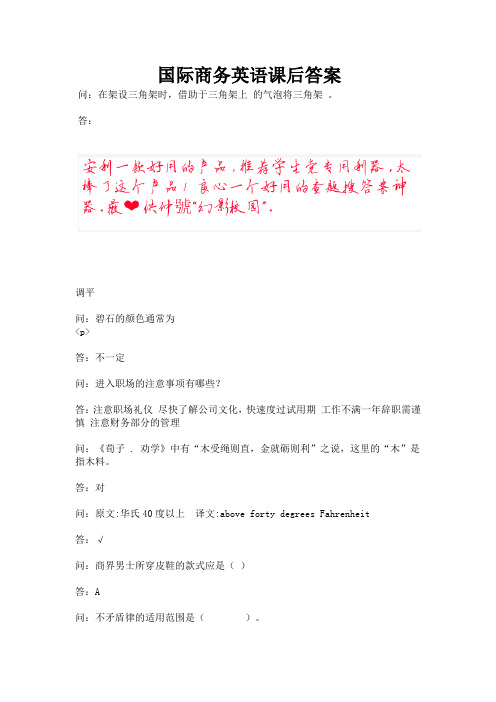
国际商务英语课后答案问:在架设三角架时,借助于三角架上的气泡将三角架。
答:调平问:碧石的颜色通常为<p>答:不一定问:进入职场的注意事项有哪些?答:注意职场礼仪尽快了解公司文化,快速度过试用期工作不满一年辞职需谨慎注意财务部分的管理问:《荀子 . 劝学》中有“木受绳则直,金就砺则利”之说,这里的“木”是指木料。
答:对问:原文:华氏40度以上译文:above forty degrees Fahrenheit答:√问:商界男士所穿皮鞋的款式应是()答:A问:不矛盾律的适用范围是()。
答:具有矛盾关系的判断具有反对关系的判断具有可同假不可同真关系的判断问:碧石的主要矿物成分是<p>答:石英问:对《易经》八卦图无论是站在从内向外看的视角,还是站在从外从外向内看的视角,其由阴爻和阳爻所组成的八种卦形中,永远不变、永远保持一致的四种卦形的名称分别是乾、坤、坎、离,分别代表天、地、水、火。
答:对问:对《易经》八卦图无论是站在从内向外看的视角,还是站在从外从外向内看的视角,其由阴爻和阳爻所组成的八种卦形中,永远不变、永远保持一致的四种卦形的名称分别是(),分别代表()。
<p>答:1 乾兑坎艮 4乾坤坎离 8天地水火问:什么是柔性基础?答:用抗拉、抗压、抗弯、抗剪均较好的钢筋混凝土材料做基础;用于地基承载力较差、上部荷载较大且基础埋深较大的建筑。
问:1. Mark the letter that identifies the tone for each of the following sentences. _____ 1) Baseball was invented as an urban game in order for owners to make money, players to become arrogant, and spectators to drink overpriced beer. A. objective B. nostalgic C. humorous答:humorous问:欧珀的最重要产地是<p>答:澳大利亚问:“上善若水”启示人们要具备如水一样的“十一种”美好品德。
国际商务课本习题部分解答DDIM

国际商务课本习题部分解答DDIM国际商务⽬录第⼀章国际商务导论第⼆章国际商务的基本理论第三章国际商务环境第四章外国经营环境第五章国际商务经营⽅式第六章国际经营战略第七章国际商务的营销战略第⼋章国际商务中的进出⼝实务第九章国际财务管理第⼗章国际⼈⼒资源管理第⼗⼀章国际商务组织与控制第⼗⼆章中国企业的国际经营第⼀章国际商务导论1.国际商务的含义和经济实质国际商务学是⼀门研究为满⾜个⼈及组织需求⽽进⾏的跨国界交易的科学。
该定义有两层含义:⼀是国际商务学研究的是跨国界的活动;⼆是国际商务学研究的是国家、企业或个⼈以经济利益为⽬的⽽进⾏的商业性经济活动,⽽不是⾮商业性的跨国经济活动(例如国家的对外经济援助)。
⾮商业性经济活动不在国际商务学的研究范围之内。
国际商务的本质是“跨国界”,最基本的国际商务活动是跨国界的经济交易活动。
国际商务学研究的主要对象是跨国公司。
跨国公司是在两个或两个以上国家设⽴分⽀机构或⼦公司进⾏跨国⽣产经营活动的企业。
2.经济全球化的含义和经济实质经济全球化(Economic Globalization) 是指世界经济活动超越国界,通过对外贸易、资本流动、技术转移、提供服务、相互依存、相互联系⽽形成的全球范围的有机经济整体。
(简单的说也就是世界经济⽇益成为紧密联系的⼀个整体)。
经济全球化是当代世界经济的重要特征之⼀,也是世界经济发展的重要趋势。
3.国内经营和国外经营的联系和区别经营环境的复杂化(⾯临不同的政治制度,法律制度和货币制度,经济环境不同,社会⽂化背景有差别)⾯临更多的机会和选择⾯临着更⼤的风险⾯临着特殊的冲突⾯临着经营决策的特殊性4,现代企业和国际商务之间的必然联系国际商务是现代企业功能的组成部分市场国际化导致了⽣产和资本越过了国界市场国际化导致了世界范围内的竞争更加激烈市场国际化导致了市场需求的趋同化和多样化趋势5.为了适应国际经营活动的需要,在经营观念上应该有哪些转变参与国际分⼯的意识按WTO原则和国际惯例办事的意识竞争的意识第⼆章国际商务的基本理论1.国际商务的基本理论是由哪些主要理论组成的?为什么选择这些理论作为国际商务的基本理论?主要有国际贸易理论,国际直接投资理论和国际⽣产理论国际贸易:古典贸易理论(重商主义,绝对优势理论,⽐较优势理论,资源配置理论),现代贸易理论(规模经济理论,产品周期理论,需求贸易理论)重商主义:认为贵⾦属(货币)是衡量财富的唯⼀标准。
韩玉军《国际商务》课后习题详解(第六章国际直接投资理论)【圣才出品】

韩玉军《国际商务》课后习题详解(第六章国际直接投资理论)【圣才出品】第六章国际直接投资理论1.试析大量外资流入对东道国贸易条件的影响。
答:贸易条件通常是从一国出口商品价格与进口商品价格相对比较的角度来进行观察和分析的。
(1)FDI通过国际收支变动效应间接影响东道国的贸易条件①外资的流入在短期内会造成国际收支盈余。
如果不转化成为额外进口,外资的流入会使东道国贸易条件好转。
但长期看,外资终究代表一种债权或利润索取权,利息、利润、管理费等的流出,要求国际收支的其他项目特别是经常项目处于盈余状态。
因此,东道国必须扩大出口,造成出口价格下降,会对一国的贸易条件产生不利影响。
②如果东道国对母国出口商品的需求弹性大于母国对该产品的需求弹性,东道国的贸易条件将会恶化。
反之,东道国的贸易条件将会好转。
(2)FDI的工资效应与东道国价格贸易条件由于工资差异能够决定物价水平差异进而决定价格贸易条件差异,故从理论上讲,在其他条件不变的情况下,一国工资水平提高会使相应产品的价格提高,如果该产品是出口品,工资水平提高会引起该国出口品价格上升,由此导致价格贸易条件改善。
以此推论,FDI 提高东道国工资水平这一效应,将导致东道国出口品的价格上升,价格贸易条件改善。
从供给角度看,工资提高意味着劳动力成本提高,如果需求等条件不变,劳动力成本提高将导致一国出口品的供给减少,由此也会带来该国出口品价格提高,价格贸易条件改善。
(3)FDI的产业流向与东道国价格贸易条件变化①一些发展中国家在利用外资过程中,过度扩张其比较优势行业,出口扩张,改变了国际市场的供求状态,造成出口价格下降,引起贸易条件恶化。
②如果FDI大量投入各国的相同产业,将会引起同类行业出口产品的恶性竞争,出口价格下降,贸易条件恶化,还会引起贸易战和保护主义泛滥。
2.在下列情况中,哪些属于对外直接投资?哪些不是?(1)一个沙特阿拉伯商人购买了1000万美元的IBM公司股票。
韩玉军《国际商务》课后习题详解(第11~15章)【圣才出品】

韩玉军《国际商务》课后习题详解第十一章国际商务组织1.请比较全球地区分部结构和全球产品分部结构,并结合组织结构阶段模型说明它们各自适合于具有什么特点的跨国公司。
答:(1)全球地区分部结构全球地区结构,又称为区域事业部制,是指跨国公司根据全球不同地区划分分部,地区分部在很大程度上是独立自治的实体,并拥有各自的价值创造活动。
地区分部拥有经营领导权和与各项价值创造活动有关的战略决策权,而总部掌握公司总的组织战略方向和财务控制权。
①优缺点:由于全球地区结构采取分权的管理方式,决策权的下放有助于促进各分部对地区的适应。
然而这种组织结构也会将组织分割成一个个高度自治的实体,阻碍地区间核心竞争力和技术的转移。
②适用性:产品多样化程度低而且国内组织结构以职能为基础的企业适合采用全球地区分部结构。
(2)全球产品分部结构全球产品分部结构是指以公司主要产品的种类及相关服务的特点为基础,在全球范围内设立若干产品分部。
每一个分部都是一个自给自足、大体上自治的实体,并对其价值创造活动负全部责任。
总部负责公司的整体组织战略发展和财务控制。
①优缺点:全球产品分部结构使得同一产品部门内有关的职能活动协调比较容易,并且每一个产品部都是一个独立的利润中心,有利于评价各部门的业绩,同时这容易适应企业的扩展与业务多元化要求。
全球产品分部结构的缺陷有:地区或各国经理被视为产品分部经理的下属,发言权受到了限制,这可能导致缺乏地区的调适;企业由于产品种类的不同而在相同的地区设立相同职能的多个机构,造成机构设置的重叠;每一个产品分部都有一定的独立权力,高层管理人员有时会难以控制;对总部的各职能部门,产品分部往往不充分利用,导致总部资源的浪费。
②适用性:产品相当多样化和原先在国内的组织结构是以产品划分部门的企业倾向于采用全球产品分部结构。
2.试述全球矩阵结构和网络型组织结构各自的优缺点。
答:(1)全球矩阵结构全球矩阵结构是把一个以项目或者产品为中心构成的组织叠加到以地区划分的组织结构之上,有关某一特定项目或产品的经营决策权由产品分部与公司的各个区域部门分享,从而使得水平差异化沿着二维方向发展:产品分部和地理区域。
国际商务英语课后题答案

6.
We are given to understand that you are a prospective buyer of Chinese arts and crafts which come within the frame of our business activities. 7. We are striving to expand economic cooperation and exchange of technology with foreign countries and will utilize common and reasonable international practices in a flexible way. 8. As requested, we are sending you, under separate cover, our latest catalogues and pricelist. 9. We are writing to offer you an opportunity to develop trade. 10. Your letter expressing the hope of establishing business connections with us has been received with thanks.
7. B: You talk the words out of my mouth. 8. B: Certainly. In order to give you a general idea of the various kinds of our products now available for export, I’d like to give you our latest catalogues and price list. 9. B: sure. We have mainly adopted some usual international practices. 10. B: Thank you. I propose a toast to the health of every one here and to the success of our future negotiations.
希尔《国际商务》课后习题详解(国际贸易理论)【圣才出品】
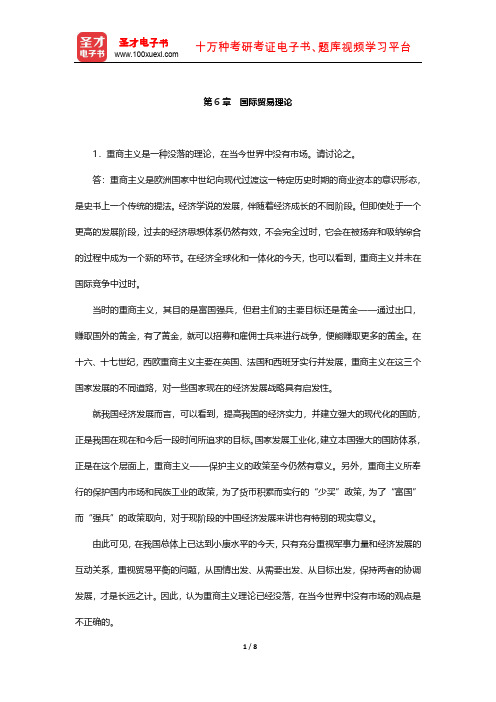
第6章国际贸易理论1.重商主义是一种没落的理论,在当今世界中没有市场。
请讨论之。
答:重商主义是欧洲国家中世纪向现代过渡这一特定历史时期的商业资本的意识形态,是史书上一个传统的提法。
经济学说的发展,伴随着经济成长的不同阶段。
但即使处于一个更高的发展阶段,过去的经济思想体系仍然有效,不会完全过时,它会在被扬弃和吸纳综合的过程中成为一个新的环节。
在经济全球化和一体化的今天,也可以看到,重商主义并未在国际竞争中过时。
当时的重商主义,其目的是富国强兵,但君主们的主要目标还是黄金——通过出口,赚取国外的黄金,有了黄金,就可以招募和雇佣士兵来进行战争,便能赚取更多的黄金。
在十六、十七世纪,西欧重商主义主要在英国、法国和西班牙实行并发展,重商主义在这三个国家发展的不同道路,对一些国家现在的经济发展战略具有启发性。
就我国经济发展而言,可以看到,提高我国的经济实力,并建立强大的现代化的国防,正是我国在现在和今后一段时间所追求的目标。
国家发展工业化,建立本国强大的国防体系,正是在这个层面上,重商主义——保护主义的政策至今仍然有意义。
另外,重商主义所奉行的保护国内市场和民族工业的政策,为了货币积累而实行的“少买”政策,为了“富国”而“强兵”的政策取向,对于现阶段的中国经济发展来讲也有特别的现实意义。
由此可见,在我国总体上已达到小康水平的今天,只有充分重视军事力量和经济发展的互动关系,重视贸易平衡的问题,从国情出发、从需要出发、从目标出发,保持两者的协调发展,才是长远之计。
因此,认为重商主义理论已经没落,在当今世界中没有市场的观点是不正确的。
2.自由贸易是公平的吗?请讨论之。
答:贸易理论认为专业化和自由贸易使所有国家都受益。
然而,使所有国家都受益并不等同于对所有国家都是公平的。
由于历史和现实的原因,不同国家的发展水平不同,在自由贸易时,尽管一个国家产品的生产更有效率,但会限制另一个国家发展生产的能力。
因此某些情况下,贸易壁垒可能会使贸易更趋于公平。
韩玉军《国际商务》课后习题详解(第一章 导论)【圣才出品】

第一章导论1.试述国际商务的概念、类型与特征。
答:(1)国际商务主要是指国际企业从事国际贸易、国际投资和国际生产过程中产生的跨国经营活动,或者说国际商务是研究围绕这些跨国经营活动产生的相关事务,包括企业的国际战略、策略,资源配置及经营管理,市场开发与拓展,如何遵守、规避国际规则,如何适应不同国家的政治、经济、文化、法律、社会环境,以及如何使自己的思想、产品或服务适应国际市场等。
(2)概括起来讲,国际商务可以分为三大类:①国际贸易,即货物与服务的进出口;②国际直接投资;③特许经营、合作经营、合作开发、工程承包与劳务合作、国际信贷与融资等贸易与直接投资以外的其他国际经济活动。
(3)国际商务的主要特征有三个方面:①国际商务是企业国际化战略的综合反映;②国际商务以进入和开拓国际市场为目标;③国际商务复杂多变、风险大。
2.试述经济全球化的含义、本质、原因与特征。
答:(1)经济全球化是世界上各国和地区之间通过商品、服务及劳动力、资本、信息、技术、管理等生产要素的跨国界流动,寻求资源最优配置的一个互相联系、互相依赖并不断深化的过程。
它主要包括贸易、生产、科技、金融、资本和劳动力流动的国际化与自由化。
(2)关于经济全球化的本质,主要有如下几种观点:①“自由派”观点认为经济全球化是资本扩张的必然结果,所以,经济全球化的本质就是资本主义化甚至可以说是美国化,是美国模式资本主义在全球取得最后胜利的标志。
具体来看这种观点包括两种主要看法:第一,全球化是跨国公司的全球化;第二,全球化的实质是美国化。
②“新马克思主义”观点或“左”派观点认为经济全球化是资本主义化、美国化,因此本质上就是经济殖民主义,是帝国主义发展的新阶段,必须坚决批判与反对。
③“怀疑派”认为历史并没有显现所谓全球化的事实,充其量不过是出现了高水平的国际化,也就是国家之间经济互动而已,经济全球化是某些理论家的神话。
④“变革论”认为全球化是21世纪推动社会经济、政治快速变革的中心力量,这些变革正在重新塑造着现在世界。
- 1、下载文档前请自行甄别文档内容的完整性,平台不提供额外的编辑、内容补充、找答案等附加服务。
- 2、"仅部分预览"的文档,不可在线预览部分如存在完整性等问题,可反馈申请退款(可完整预览的文档不适用该条件!)。
- 3、如文档侵犯您的权益,请联系客服反馈,我们会尽快为您处理(人工客服工作时间:9:00-18:30)。
国际商务课后习题参考答案HUA system office room 【HUA16H-TTMS2A-HUAS8Q8-HUAH1688】C h a p t e r1:G l o b a l i z a t i o n1. Describe the shifts in the world economy over the last 30 years. What are the implications of these shifts for international businesses based in Great Britain? North America? Hong Kong?Answer: The world economy has shifted dramatically over the past 30 years. As late as the 1960s, four stylized facts described the demographics of the global economy. The first was U.S. dominance in the world economy and world trade. The second was U.S. dominance in the world foreign direct investment picture. Related to this, the third fact was the dominance of large, multinational U.S. firms in the international business scene. The fourth was that roughly half of the globe - the centrally planned economies of the Communist world - was off-limits to Western international businesses. All of these demographic facts have changed. Although the U.S. remains the world's dominant economic power, its share of world output and world exports have declined significantly since the 1960s. This trend does not reflect trouble in the U.S. economy, but rather reflects the growing industrialization of developing countries such as China, India, Indonesia, and South Korea. This trend is also reflected in the world foreign direct investment picture. As depicted in Figure 1.2 in the textbook, the share of world output (or the stock of foreign direct investment) generated by developing countries has been on a steady increase since the 1960s, while the share of world outputgenerated by rich industrial countries has been on a steady decline. Shifts in the world economy can also be seen through the shifting power of multinational enterprises. Since the 1960s, there have been two notable trends in the demographics of the multinational enterprise. The first has been the rise of non-U.S. multinationals, particularly Japanese multinationals. The second has been the emergence of a growing number of small and medium-sized multinationals, called mini-multinationals. The fall of Communism in Eastern Europe and the republics of the former Soviet Union have brought about the final shift in the world economy. Many of the former Communist nations of Europe and Asia seem to share a commitment to democratic politics and free market economies. Similar developments are being observed in Latin America. If these trends continue, the opportunities for international business may be enormous. The implications of these shifts are similar for North America and Britain. The United States and Britain once had the luxury of being the dominant players in the world arena, with little substantive competition from the developing nations of the world. That has changed. Today, U.S. and British manufacturers must compete with competitors from across the world to win orders. The changing demographics of the world economy favor a city like Hong Kong. Hong Kong (which is now under Chinese rule) is well located with easy access to markets in Japan, South Korea, Indonesia, and other Asian markets. Hong Kong has a vibrant labor force that can compete on par with the industrialized nations of the world. The declinein the influence of the U.S. and Britain on the global economy provides opportunities for companies in Hong Kong to aggressively pursue export markets.2. "The study of international business is fine if you are going to work in a large multinational enterprise, but it has no relevance for individuals who are going to work in smaller firms." Evaluate this statement.Answer: People who believe in this view, and the firms that they work for, may find that they do not achieve their full potential (at best) and may ultimately fail because of their myopia. As barriers to trade decrease and state of the art technological developments take place throughout the world, new opportunities and threats exist on a worldwide basis. The rise of the mini-multinationals suggests there are global opportunities even for small firms. But staying attuned to international markets is not only important from the perspective of seeking profitable opportunities for small firms; it can also be critical for long-term competitive survival. Firms from other countries may be developing products that, if sold internationally, may wipe out small domestic competitors. Scanning international markets for the best suppliers is also important for small firms, for if a domestic competitor is able to tap into a superior supplier from a foreign country, it may be able to seriously erode a small firm's competitive position before the small firm understands the source of its competitor's competitive advantage and can take appropriate counter actions.3. How have changes in technology contributed to the globalization of markets and of production? Would the globalization of production and markets have been possible without these technological changes?Answer: Changes in technology have contributed to the globalization of markets and of production in a very substantive manner. For instance, improvements in transportation technology have paved the way for companies like Coca-Cola, Levi Strauss, Sony and McDonalds to make their products available worldwide. Similarly, improvements in communications technology have had a major impact. The ability to negotiate across continents has been facilitated by improved communications technology, and the rapidly decreasing cost of communications has lowered the expense of coordinating and controlling a global corporation. Finally, the impact of information technology has been far reaching. Companies can now gain worldwide exposure simply by setting up a homepage on the Internet. This technology was not available just a few short years ago. The globalization of production and markets may have been possible without improvements in technology, but the pace of globalization would have been much slower. The falling cost of technology has made it affordable for many developing nations, which has been instrumental in helping these nations improve their share of world output and world exports. The inclusion of these nations, such as China, India, Thailand, and South Korea, has been instrumental in the globalization of markets and production. In addition, improvements in global transportationand communication have made it relatively easy for business executives from different countries to converse with one another. If these forms of technology, including air-travel, fax capability, e-mail, and overnight delivery of packages were not available, it would be much more difficult for businesses to conduct international trade.4. "Ultimately, the study of international business is no different from the study of domestic business. Thus, there is no point in having a separate course on international business." Evaluate this statement.Answer: This statement reflects a poor understanding of the unique challenges involved in international business. Managing an international business is different from managing a purely domestic business for at least four reasons. These are: (1) countries are different; (2) the range of problems confronted by a manager in an international business is wider and the problems themselves more complex than those confronted by a manager in a domestic business; (3) an international business must find ways to work within the limits imposed by government intervention in the international trade and investment system; and (4) international transactions involve converting money into different currencies. As a result of these differences, there are ample reasons for studying international business as a specific field of study or discipline.5. How might the Internet and the associated World Wide Web impactinternational business activity and the globalization of the world economy? Answer: According to the text, the Internet and World Wide Web (WWW) promise to develop into the information background of tomorrow's global economy. This improved technology will not only make it easier for individuals and companies in different countries to conduct business with one another, but will also further decrease the cost of communications. These improvements will undoubtedly hasten the already rapid pace of globalization. Another distinct attribute of the Internet and the WWW is that they act as an equalizer between large (resource rich) and small (resource poor) firms. For instance, it does not cost any more for a small software firm to gain visibility via the WWW than it does for a large software company like Microsoft. As a result, the WWW helps small companies reach the size of audience that was previously only within the reach of large, resource rich firms.6. If current trends continue, China may emerge as the world's largest economy by 2020. Discuss the possible implications of such a development for(1) The world trading system.(2)The world monetary system.(3)The business strategy of today's European and U.S. based global corporations.(4)Global commodity prices.Answer: The world trading system would clearly be affected by such a development. Currently China enjoys a somewhat privileged status within theWorld Trade Organization as a “developing” country. Such a rise to eminence, however, would clearly force it to become a full and equal member, with all the rights and responsibilities. China would also be in a position to actively affect the terms of trade between many countries. On the monetary front, one would expect that China would have to have fully convertible and trading currency, and it could become one of the “benchmark” currencies of the world. From the perspective of Western global firms, China would represent both a huge market, and potentially the home base of some very capable competitors. Finally, commodity prices would probably fall.7. Read the Country Focus in this chapter on the Ecuadorian rose industry, the answer the following questions:a) How has participation in the international rose trade helped Ecuador’s economy and its people? How has the rise of Ecuador as a center for rose growing benefited consumers in developed nations who purchase the roses? What do the answers to these questions tell you about the benefits of international trade?b) Why do you think that Ecuador’s rose ind ustry only began to take of 20 years ago? Why do you think it has grown so rapidly?c) To what extent can the alleged health problems among workers in Ecuador’s rose industry be laid at the feet of consumers in the developed world and their desire for perfect Valentine’s Day roses?d) Do you think governments in the developed world should place trade sanctions on Ecuador roses if reports of health issues among Ecuadorian rose workers are verified? What else might they do to improve the situation in Ecuador?a) Ecuador is the world’s fourth largest producer of roses. In fact, roses represent the country’s fifth largest export. The industry is vital to Ecuador’s economy, creating tens of thousands of jobs, jobs that pay significantly above the country’s minimum wage. Taxes and revenues from the rose growers have also helped to pave roads, build schools, and construct sophisticated irrigation systems. For Ecuador’s consumers, the success of the industry means bigger, more vibrant flowers than were previously available. Most students will recognize that the conditions in Ecuador give the country a distinct advantage in rose growing, and that by focusing on the industry, Ecuador has been able to benefit from international trade. Consumers in other countr ies also benefit from Ecuador’s flower exports with better products.b) Ecuador’s rose industry began some 20 years ago, and has been expanding rapidly ever since then. Most students will probably focus advances in technology as a key to the industry’s s uccess. Roses are a very fragile, perishable product. Modern technology enables growers to used refrigerated air transport to get the product to markets around the globe. Without that ability, the growers would be limited to the market immediately surroundingthe country.c) Students will probably be divided on this issue with some students arguing that consumers are to blame for the problems, and others placing the blame on the growers. Students taking the first perspective will probably suggest that most consumers purchase their roses with little consideration for how they are grown. Rather, most consumers simply focus on their beauty and price. Students blaming the growers might argue that growers, because they feel the effect of less-than-perfect roses in the form of smaller profits, will be motivated to find ways to produce ever more perfect flowers. Certainly, the use of pesticides and other products can produce a better crop. In the end, there is probably blame on both sides. If more consumers were aware of the health problems resulting from the improper use of pesticides, they would probably demand some changes. Similarly, if pressure were put on the growers to use pesticides safely, health problems could be reduced.d) Trade sanctions are a tool that is often employed by governments that are making a statement against a specific action or actions. In the case of Ecuador, trade sanctions certainly would be an option, as would publicizing the situation so that more consumers were aware of the conditions. In the end though, it is important to consider the effect of the sanctions or other measures on people like Maria who might lose their livelihood as a result. Chapter 2: National Differences1. Free market economies stimulate greater economic growth, whereas state-directed economies stifle growth! Discuss.Answer: In a market economy, private individuals and corporations are allowed to own property and other assets. This right of ownership provides a powerful incentive for people to work hard, introduce new products, develop better advertising campaigns, invent new products, etc., all in the hopes of accumulating additional personal capital and wealth. In turn, the constant search on the part of individuals and corporation to accumulate wealth enriches the entire economy and creates economic growth. In contrast, in a command economy, private individuals and corporations are not allowed to own substantial quantities of property and other assets. The objective of a command economy is for e veryone to work for “the good of the society.” Although this sounds like a noble ideal, a system that asks individuals to work for the good of society rather than allowing individuals to build personal wealth does not provide a great incentive for people to invent new products, develop better advertising campaigns, find ways to be more efficient, etc. As a result, command economies typically generate less innovation and are less efficient than market economies.2. A democratic political system is an essential condition for sustained economic progress. Discuss.Answer: This question has no clear-cut answer. In the West, we tend to arguethat democracy is good for economic progress. This argument is largely predicted upon the idea that innovation is the engine of economic growth, and a democratic political system encourages rather than stifles innovation. However, there are examples of totalitarian regimes that have fostered a market economy and strong property rights protection and experienced rapid economic growth. The examples include four of the fastest growing economies of the past 30 years – South Korea, Taiwan, Singapore, and Hong Kong – all of which have grown faster than Western economies. However, while it is possible to argue that democracy is not a necessary precondition for the establishment of a free market economy, it seems evident that subsequent economic growth leads to establishment of democratic regimes. Several of the fastest-growing Asian economies have recently adopted more democratic governments.3. What is the relationship between corruption (i.e., bribe taking by government officials) in a country and economic growth? Is corruption always bad?Answer: Economic evidence suggests that high levels of corruption significantly reduce the economic growth rate in a country. By siphoning off profits, corrupt politicians and bureaucrats reduce the returns to business investment, and hence, reduce the incentive that both domestic and foreign businesses have to invest in that country. The lower level of investment that results has a negative impact on economic growth. However, while most studentswill probably agree that corruption is bad, some may point out that the U.S., despite its Foreign Corrupt Practices Act, does allow “grease payments” to expedite or secure the performance of a routine governmental action. According to Congress, “grease payments” while technically bribes are not being used to obtain or maintain business, but rather are simply made to facilitate performance of duties that the recipients are already obligated to perform. 4. The Nobel prize-winning economist Amartya Sen argues that the concept of development should be broadened to include more than just economic development. What other factors does Sen think should be included in an assessment of development? How might adop tion of Sen’s views influence government policy? Do you think Sen is correct that development is about more than just economic development? Explain.Answer: Sen has argued that development be assessed less by material output measures such as GNP per capita, and more by the capabilities and opportunities that people enjoy. Sen suggests that development be seen as a process of expanding real freedoms that people experience, and as such, that development requires the removal of major impediments to freedom. Governments influenced by Sen might ensure that basic health care and education programs are available especially for women. Many students will agree with Sen and the notion that development is not just an economic process, but a political one too, and that to succeed citizens must be given a voice in the important decisions made for the country.5. You are the CEO of a company that has to choose between making a $100 million investment in either Russia or the Czech Republic. Both investments promise the same long-run return, so your choice of which investment to make is driven by considerations of risk. Assess the various risks of doing business in each of these nations. Which investment would you favor and why? Answer: When assessing the risks of investment, one should consider the political, economic, and legal risks of doing business in either Russia or the Czech Republic. At this time (Fall 2002), the risk in Russia would probably be considered higher than the risk in the Czech Republic. The Czech Republic has just been accepted as a future member of the EU, and as such gains the benefits and stability offered by the EU. Russia, by contrast, is still many years away from even being in a position to be considered by the EU for membership. Depending upon when you are using the book, this situation could be different. (You also may want to substitute other countries into this question depending on current events and the countries with which you feel your students will be most familiar.)6. Read the Country Focus on India in this chapter and answer the following questions:a. What kind of economic system did India operate during 1947-1990? What kind of system is it moving towards today? What are the impediments to completing this transformation?b. How might widespread public ownership of businesses and extensive government regulations have impacted (i) the efficiency of state and private businesses, and (ii) the rate of new business formation in India during the 1947-1990 time frame? How do you think these factors affected the rate of economic growth in India during this time frame?c. How would privatization, deregulation, and the removal of barriers to foreign direct investment affect the efficiency of business, new business formation, and the rate of economic growth in India during the post-1990 time period?d. India now has pockets of strengths in key high technology industries such as software and pharmaceuticals. Why do you think India is developing strength in these areas? How might success in these industries help to generate growth in other sectors of the Indian economy?e. Given what is now occurring in the Indian economy, do you think that the country represents an attractive target for inward investment by foreign multinationals selling consumer products? Why?Answer:a. The economic system that developed in India after 1947 was a mixed economy characterized by a large number of state-owned enterprises, centralized planning, and subsidies. In 1991, India’s government embarked on anambitious economic reform program. Much of the industrial licensing system was dismantled, and several areas once closed to the private sector were opened. In addition, investment by foreign companies was welcomed, and plans to start privatizing state-owned businesses were announced. India has posted impressive gains since 1991, however there are still impediments to further transformation. Attempts to reduce import tariffs have been stalled by political opposition from employers, employees, and politicians. Moreover, the privatization program has been slowed thanks to actions taken by the Supreme Court. Finally, extreme poverty continues to plague the country.b. The mixed economy that developed in India after 1947 was characterized by a large number of state-owned enterprises, centralized planning, and subsidies. This system not only constrained the growth of the private sector, but it also consequently limited the effects of competition that typically promote efficiency and productivity in a free market system. The system even limited the actions of private companies, requiring them to get government approval for routine business activities. Production quotas and high import tariffs also stunted the development of a healthy private sector, as did restrictive labor laws that made it difficult to fire employees. Foreign exchange restrictions, limitations on foreign investment, controls on land use, and managed prices further exacerbated the situation. It would appear that India’s rate of economic growth was negatively affected during this time frame. By 1994, India’s economy was still smaller than Belgium’sdespite having a large population. Both GDP and literacy rates were very low, and some 40 percent of the population lived in poverty.c. In 1991, India’s government embarked on an ambitious economic reform program. So far, the response to the program has been impressive. The economy expanded at an annual rate of about 6.3 percent from 1994 to 2004. Foreign investment is up from $150 million in 1990 to $6 billion in 2005. Certain sectors of the economy including information technology and pharmaceuticals have done particularly well. Still, problems persist. Actions taken by the government continue to limit efficiency gains for private companies and the country’s high rate of poverty is still a major problem.d. India’s gains in information technology and pharmaceuticals are impressive. The country has emerged as a vibrant global center for software development, and India’s pharmaceutical companies have taken a strong global position by selling low cost generic versions of drugs that have come of patent in the developed world. As these industries continue to prosper, other sectors of the economy should also see the benefit of spillover effects.e. Foreign investment is up in India. In fact, foreign investment rose from $150 million in 1990 to $6 billion in 2005. However, whether India is an attractive destination for foreign multinationals selling consumer products remains to be seen. Certainly, the large population will serve to attractsome companies, but the fact that some 40 percent of the population is living in abject poverty will scare other companies away. Moreover, it is still not easy to run a company in India thanks to laws limiting everything from who can be fired to who can which products.Chapter 3: Differences in Culture1. Outline why the culture of a country influences the costs of doing business in that country. Illustrate your answer with examples.Answer: Since in a sense the entire chapter is about this question, there can be numerous reasons and examples of how culture influences the costs of doing business. Several are highlighted in the following sentences, but there could be numerous others. When there are simply different norms between how individuals from different countries interact, the costs of doing business rise as people grapple with unfamiliar ways of doing business. For example, while in the US we may get down to business first, and then get to know each other socially later, in many South American countries it is important develop a good social relationship before trying to discuss business issues. Different class structures and social mobility also raise the costs of doing business, for if there are inhibitions against working with people from different classes, then the efficiency with which information can flow may be limited and the cost of running a business increased. A country's religion can also affect the costs of business, as religious values can affectattitudes towards work, entrepreneurship, honesty, fairness, and social responsibility. In Hindu societies where the pursuit of material well-being can be viewed as making spiritual well being less likely, worker productivity may be lower than in nations with other religious beliefs. Finally, a country's education system can have important implications for the costs of business. In countries where workers receive excellent training and are highly literate, the need for specific worker training programs are decreased and the hiring of additional employees is facilitated.2. Do you think business practices in an Islamic country are likely to differ from business practices in the United States? If so, how?Answer: A number of aspects of the cultural differences between an Islamic country and the USA will cause business practices to differ. The role women can take, appropriate etiquette (including simple things like not passing papers with the left hand), holidays, and wining and dining all differ from in the USA. But beyond these, the underlying philosophy and role of business differs from in the USA. Since Muslims are stewards of property for God, rather than owners, they are more likely to use their resources carefully and may be less likely to give up or sell something to a person who may not practice the same stewardship. The importance of fairness to all parties in relations means that over-aggressiveness in self-interest may not be well received, and breaking an agreement, even if technically/legally permissible may be viewed as very inappropriate. Finally, the prohibitions on interestpayments in some Islamic countries means that the wording of the terms of an agreement must be done carefully so that "fair profits" are not construed as being "interest payments."3. What are the implications for international business of differences in the dominant religion of a country?Answer: Differences in the dominant religion of a country affect relationships, attitudes toward business, and overall economic development. Firstly, differences in religion require inter-cultural sensitivity. This sensitivity requires things like simply knowing the religious holidays, accepting that some unexpected things may happen "because of Allah's will," or understanding how interpersonal relationships may be different between "believers" and "non-believers." (Hence non-believers may be treated differently.) Secondly, religious beliefs can significantly affect a countries attitude toward business, work, and entrepreneurship. In one country successfully beating a competitor may be considered a great achievement while in another it may be thought of as showing a lack of compassion and disruptive to the society and persons involved, both attitudes that may be derived from underlying religious beliefs. Likewise, hard work may be either rewarded positively or viewed as something of secondary importance to spiritual peace and harmony. Thirdly, different dominant religions may affect the overall competitiveness and potential for economic growth of a nation, and hence attractiveness of a country for international business.。
